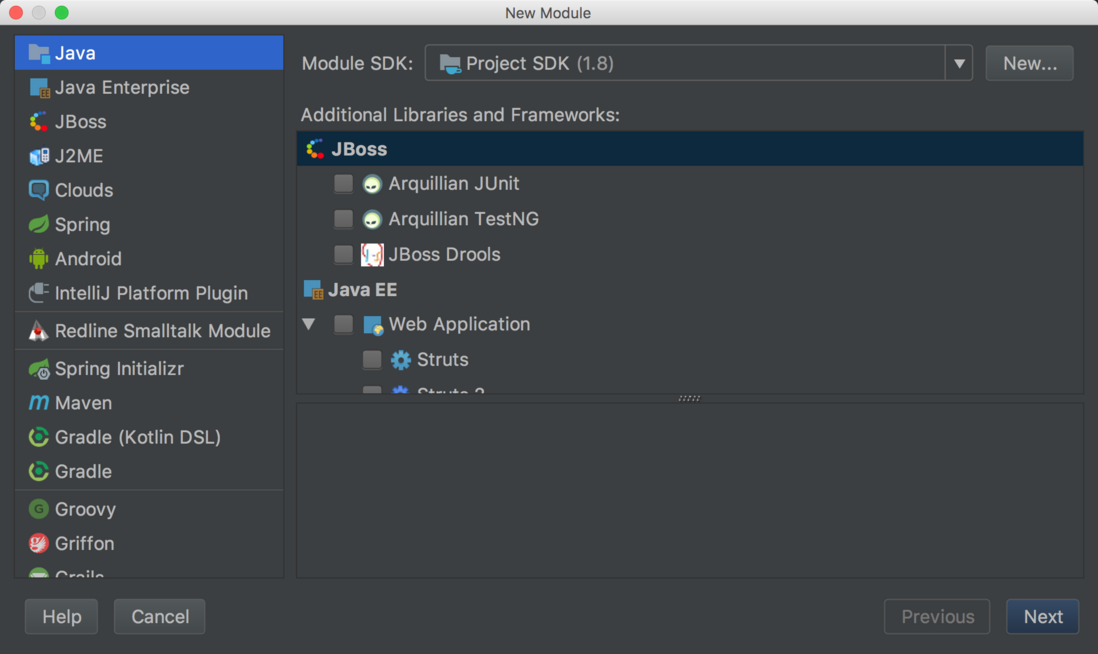本文介绍了用Idea搭建OSGI项目开发的过程,演示使用的JDK8,Equinor OSGI Framework。
OSGI简介
OSGI的全称是Open Service Gateway Initiative,直译就是开放服务网关。最新的OSGI定义是The Dynamic Module System for Java,即面向java的动态模块化系统。
在传统Web开发中,我们为了进行功能的分离,经常会进行模块划分,比如基础信息模块交由A和B做,接口信息模块交由C和D做。最终,再汇集到一起,组成一个完整的项目。在这整一个流程中,我们做到的只是逻辑上的解耦,最终这些模块还是运行于同一服务器上,共享同一个classpath。这时就会出现一个局限性问题,比如现在接口规范改了,我只想停掉接口信息模块,而基础信息模块仍能正常运行,这显然是无法实现的。而使用OSGI可以完美解决这个问题,OSGI是基于模块(Bundle)驱动的,每个模块都有属于自己的classpath和类加载器,模块之间通过服务注册和发现进行关联,每个模块有着自己独立的生命周期,我们可以动态地对模块进行加载、卸载、更新。摘自https://www.jianshu.com/p/11d...。
OSGI可以理解成是JVM单进程内的SOA,当然也支持多进程分布式的模块之间的调用。
Equinor下载
下载地址:https://download.eclipse.org/...
本文下载的是equinox-SDK-4.11.zip,下载后进行解压,后面需要用到这个解压目录。
Idea创建OSGI工程
File -> New -> Project,选择Java,点击Next,创建一个空工程。
继续点击Next。
填写项目名称,这里叫osgi_demo。
分别创建api、server、client三个OSGI模块。
创建模块时勾选OSGI作为开发环境,Use library从刚才下载的Equinox解压的目录下的plugins目录中选择org.eclipse.osgi_3.13.300.v20190218-1622.jar。
创建模块完成之后,打开idea的preferences,在Languages & Frameworks找到OSGI Framework Instances选项。
添加Equinox,Home directory选择刚才解压的Equinox目录。
编写演示代码
结构如下图
api模块中定义接口类IHelloService
package osgi.demo.api;
public interface IHelloService {
/**
* 和某人打招呼
* @param somebody
* @return
*/
String sayHello(String somebody);
}
server模块接口实现类HelloServiceImpl
package osgi.demo.server;
import osgi.demo.api.IHelloService;
public class HelloServiceImpl implements IHelloService {
@Override
public String sayHello(String somebody) {
return "hello " + somebody;
}
}server模块服务注册类HelloServerBundle
package osgi.demo.server;
import org.osgi.framework.BundleActivator;
import org.osgi.framework.BundleContext;
import osgi.demo.api.IHelloService;
import java.util.Dictionary;
import java.util.Hashtable;
public class HelloServerBundle implements BundleActivator {
@Override
public void start(BundleContext bundleContext) throws Exception {
IHelloService service = new HelloServiceImpl();
Dictionary<String , Object> properties = new Hashtable<>();
//服务注册
bundleContext.registerService(IHelloService.class, service, properties);
}
@Override
public void stop(BundleContext bundleContext) throws Exception {
}
}client模块调用服务类HelloClientBundle
package osgi.demo.client;
import org.osgi.framework.BundleActivator;
import org.osgi.framework.BundleContext;
import org.osgi.framework.ServiceReference;
import osgi.demo.api.IHelloService;
import java.util.Objects;
public class HelloClientBundle implements BundleActivator {
@Override
public void start(BundleContext bundleContext) throws Exception {
//获取到IHelloService服务引用
ServiceReference<IHelloService> reference = bundleContext.getServiceReference(IHelloService.class);
if (Objects.nonNull(reference)) {
//发现服务
IHelloService service = bundleContext.getService(reference);
if (Objects.nonNull(service)) {
System.out.println(service.sayHello("jecyhw"));
}
//注销服务
bundleContext.ungetService(reference);
}
}
@Override
public void stop(BundleContext bundleContext) throws Exception {
}
}各模块OGSI配置
api模块配置,导出接口定义所在包osgi.demo.api(Additional properties是bundle的相关属性配置的地方)。
server模块配置,配置HelloServerBundle类作为该bundle的启动类。
client模块配置,配置HelloClientBundle类作为该bundle的启动类。
osgi启动配置并运行
选择Edit Configurations。
添加OSGI Bundles。
配置如下。
client模块调用了server的服务,按照依赖关系,server模块需要先启动,把服务注册在osgi框架中,client模块才能调用到,Start level是用来定义bundle模块的启动优先级,值越小,启动优先级越高。
Framework start level是整个osgi框架的启动级别,也就是整个项目的启动级别,大于这个值的bundle模块是不会被启动的。如果这个值为1,client模块的启动级别为2,client模块是不会被启动的,可以调整试试。
点击OK之后,就可以运行了。
运行结果截图。
参考资料
Java模块化之路 —— OSGI介绍
深入理解OSGi:Equinox原理、应用与最佳实践

















**粗体** _斜体_ [链接](http://example.com) `代码` - 列表 > 引用。你还可以使用@来通知其他用户。